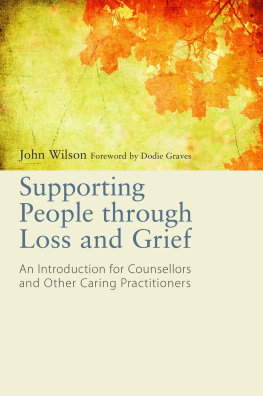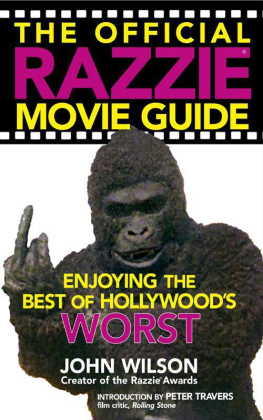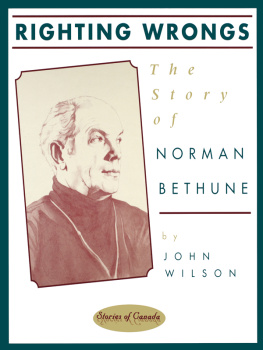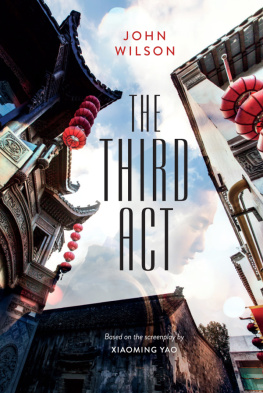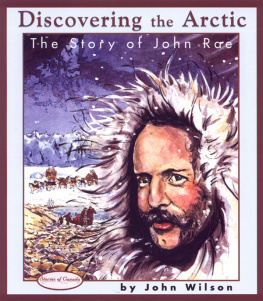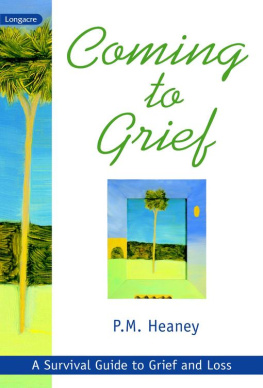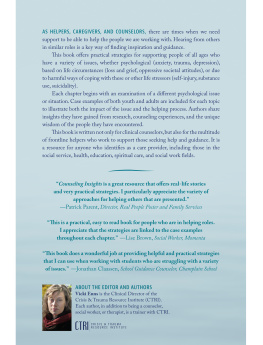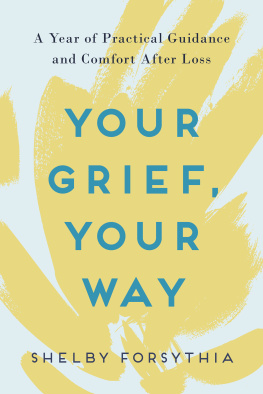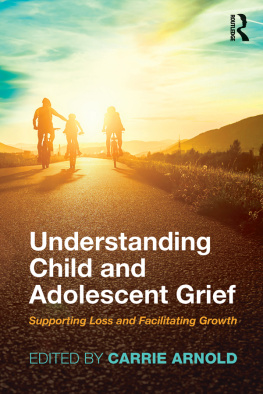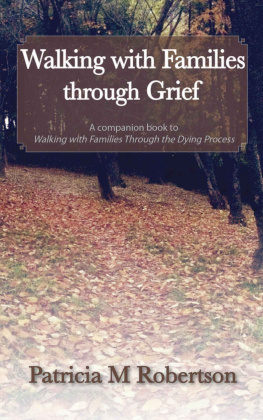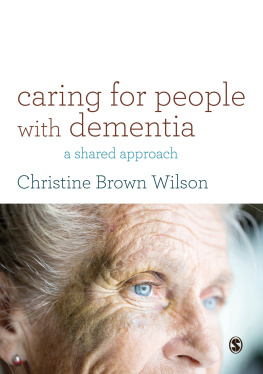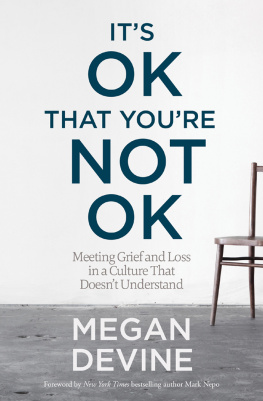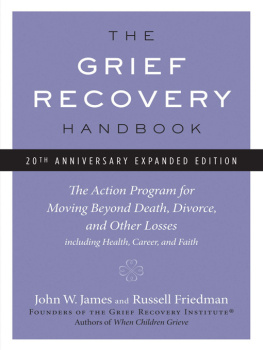Acknowledgements
A book like this is never written by one person. The perspiration is mine but most of the inspiration belongs to others. I would like to acknowledge these people.
Most importantly I would like to thank my clients who have taught me so much about loss and grief. I would like to thank my colleagues at Saint Catherines Hospice, in particular the Bereavement Supporters who have taken the time to ask about the projects progress. Thanks are due to my PhD supervisors, Lynne Gabriel and Hazel James, for helping me manage my research alongside this project, and to my counselling supervisor, Lucy Birtwistle, whose knowledge, skill and compassion continue to play a role in my professional development. Warm appreciation goes to my immediate colleagues Jan Pocknall, Flynne Readman, Martyn Tinker and Ann Wells, for both the loving support and the professional conversations that have contributed to this book. A very special thanks go to my Manager Kath Atherton and our Service Coordinator Mollie Woollard, similarly for their love and professional reflections, but also for tolerating my distracted lapses in departmental paperwork. I apologize for the extra pressure this has placed on you both.
I wish to express my gratitude to Katherine McGilly, Hilary Minter and Greg OSullivan for reading and commenting on chapters, to Stacey Sutton for proofreading the final draft and to the researchers and clinicians in this field that have taken time to read and comment on those sections of the manuscript that draw on their particular expertise: Sharon Cornford, Dodie Graves, Linda Machin, Robert Neimeyer, Colin Murray Parkes, Margaret Stroebe and Lois Tonkin. owes its existence to Golnar Bayat; in essence, the text of this chapter is hers.
Thanks to those who have generously granted permission to use diagrams I have taken from their own work and to Curtis Brown Ltd, agents for the estate of Laurie Lee, for permission to use the quote at the head of .
Final thanks go to my wonderful wife, Sandra, in part for putting up with the back of my head for the past six months, but especially for her ability with English grammar. Her contribution to punctuating the text has considerably improved its readability.
Appendix 9.1
Relating What I Have Learnt to the TEB Cycle
(After an Idea by Faulkner and Wallbank 1998)
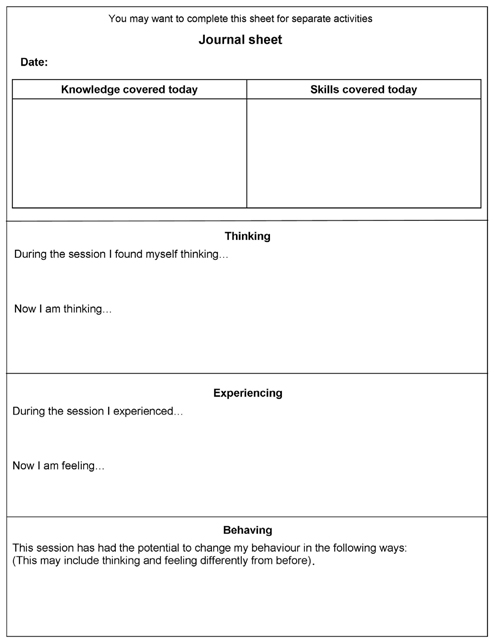
Appendix 9.2
The Continuum Exercise
This activity requires a large teaching space. On opposite walls, tack two signs. One should read Strongly agree and the opposite one should read Strongly disagree.
Invite your students to stand in a group mid-way between the two signs. Then read from a list of statements designed to elicit each students opinion, belief or philosophical position.
For example, you may read out:
We each have a right to decide when we will die.
Or:
I will always strive to prevent a clients suicide.
Invite each student to stand between the two signs in a place that reflects the strength of his or her feeling. Invite each student to explain his or her position.
Appendix 9.3
Suggested Module Programme
Day 1
Introductions and contracting:
Students individual expectations
Ground rules, expectations
Models of learning:
Kolbs Learning Cycle
TEB cycle
Joharis Window
Keeping a reflective journal
Confidentiality:
Personal constructs and professional models
Stages of life experience:
Life changes
Personal narrative exercise
Study skills
Internet skills
Library skills
Independent study to build up a resource
Listening skills, theory and practice:
Listening skills active listening
Giving and receiving feedback appropriately
Day 2
Attachment and loss:
Presentation of attachment theory
Personal loss exercise
Personal attitudes and beliefs about loss sexuality, age, disability
Personal attitudes to death and dying
The helping relationship:
Working within boundaries
Carl Rodgers and the humanistic philosophy of self-actualization
The core conditions
Skills theory and practice:
Introducing triads
Giving feedback in your triad
Active listening
Barriers to effective listening
Day 3
Preparing to do the assignments:
Working definitions of bereavement, grief, grieving, mourning
Grief in a historical context
Factors affecting grief
The concept of complicated grief
Attachment styles developed: the work of Hazan and Shaver, and the work of Colin Murray Parkes (2006)
Skills theory and practice:
Using the core conditions:
Paraphrasing, reflecting, clarifying and summarizing
Day 4
The complexity of grief:
Active self-healing: the clients role
The role of the helping practitioner
Models of grief:
Assumptive world theory
Finding meaning, making sense
Grief and growth: Lois Tonkins Circles Model
Skills theory and practice:
Second level skills: focusing
Deeper level empathy
Day 5
Models of grief:
The Dual Process Model
Instrumental and intuitive grief
Linda Machins RRL model
Continuing bonds theory
Skills theory and practice:
Challenge and confrontation
Day 6
Working with difference
Skills theory and practice:
The concept of transference
Day 7
A systems approach to family grief:
Family sculpture
Skills theory and practice:
Supervision: its function, and how to make best use of it
Revising and consolidating listening skills
Day 8
Skills assessment
Rituals and endings
Ending with one another
Tutorials
Author Index
Abraham, K.,
Adams, L.,
Ainsworth, M.,
Ainsworth, M.D.S.,
Alford, J.,
Alvarez, W.,
Anderson, C.,
Archer, J.,
Archer, N.,
Atherton, J.S.,
Atherton, K.,
Attig, T.,
Averill, J.R.,
Bayat, G.,
Begley, S.,
Binswanger, L.,
Bloch, S.,
Boelen, P.A.,
Boerner, K.,
Bohart, A.C.,
Bond, T.,
Boorse, C.,
Bowen, M.,
Bowlby, J.,
Bowlby, R. (father of John),
Bowlby, R. (son of John),
Bowlby, T.,
Bowlby-West, L.,
Bretherton, I.,
Brown, R.J.,
Brcke, E.,
Burke, L.A.,
Callender, R.,
Capra, F.,
Carey, T.,
Carr, D.,
Chan, C.L.W.,
Chapman, A.,
Childs-Gowell, E.,
Clarke, D.,
Clukey, L.,
Coldridge, L.,
Cooper, M.,
Cooper, R.,
Cornford, S.,
Counts, D.A.,
Counts, D.R.,
Cozolino, L.J.,
Cuijpers, P.,
Currier, J.M.,
Damasio, A.,
Darwin, C.,
Davis, C.G.,
Dewey, J.,
Digby, K.,
Doka, K.,
Doka, K.J.,
Doolittle, H.,
Engel, G.L.,
Evers, K.E.,
Faulkner, A.,
Ferenczi, S.,
Folkman, S.,
Ford, H.,
Frank, E.,
Freud, A.,
Freud, J.,
Freud, S.,
Fry, M.,
Gabrieli, V.,
George, C.,
Gerson, R.,
Gilbert, K.R.,
Gittings, C.,
Glover, E.,
Gordon, T.,
Gorscak, B.,
Graves, D.,
Grosskurth, P.,
Gndel, H.,
Hall, E.T.,
Hansen, E.,
Hansson, R.O.,
Harlow, H.F.,
Hazan, C.,
Hinde, R.,
Horowitz, M.J.,
Hunt, K.,
Huxley, J.,
Immordino-Yang, M.H.,
Ingham, H.,
Jacobs, J.,
Jacobs, M.,
Janoff-Bulman, R.,
Jordan, J.R.,
Jupp, P.C.,
Kai, J.,
Kaplan, N.,
Kaufmann, G.,
Keats, J.,
Keesee, N.J.,
Next page
